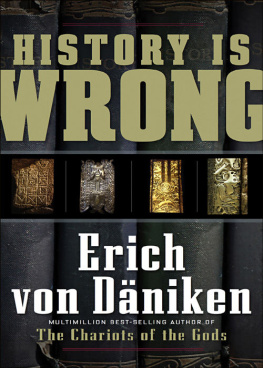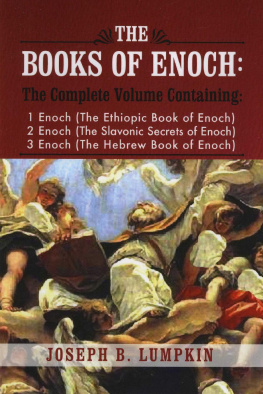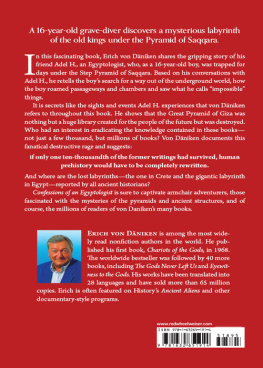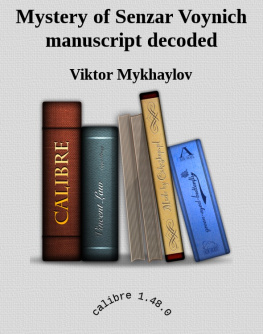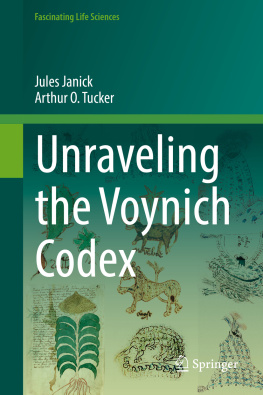Däniken - History Is Wrong
Here you can read online Däniken - History Is Wrong full text of the book (entire story) in english for free. Download pdf and epub, get meaning, cover and reviews about this ebook. City: Franklin Lakes;N.J, year: 2009, publisher: Red Wheel;Weiser;New Page Books, genre: Religion. Description of the work, (preface) as well as reviews are available. Best literature library LitArk.com created for fans of good reading and offers a wide selection of genres:
Romance novel
Science fiction
Adventure
Detective
Science
History
Home and family
Prose
Art
Politics
Computer
Non-fiction
Religion
Business
Children
Humor
Choose a favorite category and find really read worthwhile books. Enjoy immersion in the world of imagination, feel the emotions of the characters or learn something new for yourself, make an fascinating discovery.
History Is Wrong: summary, description and annotation
We offer to read an annotation, description, summary or preface (depends on what the author of the book "History Is Wrong" wrote himself). If you haven't found the necessary information about the book — write in the comments, we will try to find it.
Däniken: author's other books
Who wrote History Is Wrong? Find out the surname, the name of the author of the book and a list of all author's works by series.
History Is Wrong — read online for free the complete book (whole text) full work
Below is the text of the book, divided by pages. System saving the place of the last page read, allows you to conveniently read the book "History Is Wrong" online for free, without having to search again every time where you left off. Put a bookmark, and you can go to the page where you finished reading at any time.
Font size:
Interval:
Bookmark:
History Is Wrong
ERICH VON DNIKEN
Translated by Nicholas Quaintmere

Copyright 2009 by Erich von Dniken
All rights reserved under the Pan-American and International Copyright Conventions. This book may not be reproduced, in whole or in part, in any form or by any means electronic or mechanical, including photocopying, recording, or by any information storage and retrieval system now known or hereafter invented, without written permission from the publisher, The Career Press.
Unless otherwise noted, images are from the authors personal collection.
HISTORY IS WRONG
EDITED BY JODI BRANDON
TYPESET BY EILEEN MUNSON
Cover design by Howard Grossman / 12E Design
Printed in the U.S.A.
To order this title, please call toll-free 1-800-CAREER-1 (NJ and Canada: 201-848-0310) to order using VISA or MasterCard, or for further information on books from Career Press.

The Career Press, Inc., 220 West Parkway, Unit 12
Pompton Plains, NJ 07444
www.careerpress.com
www.newpagebooks.com
Library of Congress Cataloging-in-Publication
Data Dniken, Erich von, 1935
History is wrong / by Erich von Dniken.
p. cm.
Includes index.
ISBN 978-1-60163-086-5
1. Civilization, AncientExtraterrestrial influences. 2. Life on other planets. I. Title.
CB156.D3323 2009
001.942--dc22
2009024184
www.redwheelweiser.com
www.redwheelweiser.com/newsletter
My quick survey only took a couple of days. I started with my wife, the apple of my eye, and continued at the office. I asked everyone the same question. Then I called some of my relatives and laterfeeling a little pluckiereven complete strangers in a restaurant. Excuse me. Could I ask you a question? I was politeas one iseven though a lot of the guests simply wrinkled their brows in puzzlement, seemingly asking themselves, What the hell does this guy want? But in the end I had asked a hundred people, and that was enough.
Have you ever heard of the Voynich manuscript?
The w-h-a-t?
Out of one hundred people, only one had ever heard of the Voynich manuscript, and even then knew nothing of any consequence. Voynich manuscript? Wasnt there something about that in P.M. magazine in Germany? It contains the entire history of this puzzling and crazy document, including much of the speculation and attempts at deciphering the text.
To be honest, just about everything that could be written about the Voynich manuscript has already been written, so it makes no sense to repeat it here. Nevertheless, there are still a few blank spots on the world map of Voynich scholarshipinterconnections that I have never encountered in any of the literature about the Voynich manuscript. Our way of thinkingso we believeis characterized by logic and information. In reality, we are just like the verses of an enormous book, from which we dont even know the first 4,000 pages. Were living on a single page. And in terms of the entire composition, we know neither the vocabulary nor even the alphabet. Todays reason cannot accept the reason of the past. And in so saying, I turn to the people who have remained intelligent, even while being a part of academia. My readers shouldnt end up like the hundred people I had questioned earlier. So, for that reason, Id like to tell you a little about the incredible Voynich manuscript.
On October 31, 1865, in the city of Telia in Lithuania, the Wojnicz family was blessed by the arrival of a son. Records show that they christened him Michal, but he changed this in later life to Wilfryd. His father held a position in a government office and sent him first to school and then to university in Moscow, where he studied chemistry and qualified as a pharmacist. He became politically active, becoming involved with the Polish nationalist movement, which was fighting to liberate Poland from the Russians. He joined a group of young activists who were attempting to save two of their comrades from execution. This led to his arrest in 1885 and incarceration in solitary confinement in a Warsaw prison. In the summer of 1887, Wilfryd was to be transported to a prison camp in Siberia, but somehow he escaped and went on the run. He made his wayno one quite knows howto London, where he resurfaced three years later.
Living in the London suburb of Chiswick, he met up with a group of fanatical Englishmen and exiled Russians bent on ending the rule of the czar. They published a revolutionary magazine called Free Russia, which Wilfrid Voynich (having anglicized his name) sold on the streets. With the help of his girlfriend, Ethel Boole, he worked his way up to becoming manager of a small bookshop. In September 1902, the two marriednot purely for love, partially for convenience, as Wilfrid wanted to take on British nationality and he could only do this by marrying a British citizen.
The richly colored manuscript had lain hidden in an old chest and nobody had known of its existence. The entire work is written down on parchment and illustrated with countless color drawings, and he had immediately suspected that it was produced sometime in the second half of the 13th century.
Since that time, the unreadable work has been known as the Voynich manuscript.
A while after Voynichs death (on March 19, 1931) it became known that his claim to have found the manuscript in an old castle was a fabrication. Wilfrid left behind a will in which he left the manuscript to his wife, Ethel, and his secretary, Anne Nill. After Ethels death Anne Nill became the sole owner of the Voynich manuscript, and she confessed in a letter that was not to be published until after her death, that Wilfrid had found the manuscript in 1912 in a former Jesuit collegio, in the Villa Mandragone. This villa had been a Jesuit training center and had housed an impressive collection of old manuscripts from the library of the Collegium Romanum. In 1870, the Jesuits had feared that Vittorio Emanuels soldiers might plunder the library to make themselves a bit of money, so the collection was transferred to the Villa Mandragone in Frascati, north of Rome. This was where Voynich discovered the manuscript, while rummaging around in an old trunk. The Jesuits had needed money for restoration work to their ramshackle building and the brothers had readily offered the crafty bookseller from London cases full of yellowing manuscripts. Voynich purchased 30 old volumes and the Jesuits, who had thought themselves sly, never realized what a treasure they had pressed into Wilfrid Voynichs willing hands.
To an antiquarian like Wilfrid Voynich, who regularly dealt with piles upon piles of ancient texts, the curious, multicolored parchment in the heavy dark brown and matt-varnished trunk must have really leapt out and caught the eye. But what truly surprised him was a letter he found pressed between the front cover and the first page. This letter, composed in Latin, had been written by a certain Johannes Marcus Marci de Cronland in Prague and was dated August 19, 1666. It was addressed to his friend Athanasius Kircher and explained how he was sending him a work that no one could read. If anyone could decipher the text, he wrote, it would be Athanasius. On the origin of the manuscript, Marci wrote:
Next pageFont size:
Interval:
Bookmark:
Similar books «History Is Wrong»
Look at similar books to History Is Wrong. We have selected literature similar in name and meaning in the hope of providing readers with more options to find new, interesting, not yet read works.
Discussion, reviews of the book History Is Wrong and just readers' own opinions. Leave your comments, write what you think about the work, its meaning or the main characters. Specify what exactly you liked and what you didn't like, and why you think so.

